Fulfillmenthouse
On this page, you find all documents, package deals, and flashcards offered by seller fulfillmenthouse.
- 5
- 0
- 0
Community
- Followers
- Following
5 items
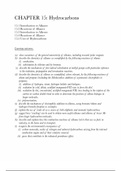
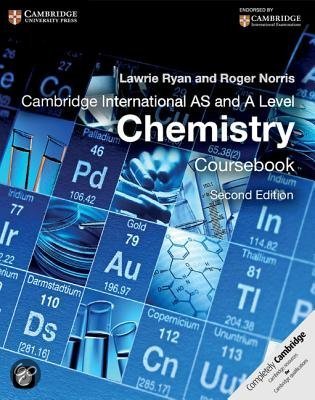
Chemistry As and A level- Hydrocarbons
15.1 Introduction to Alkanes 15.2 Reactions of Alkanes 15.3 Introduction to Alkenes 15.4 Reactions of Alkenes 15.5 Uses of Hydrocarbons Learning outcomes: (a) show awareness of the general unreactivity of alkanes, including towards polar reagents. (b) describe the chemistry of alkanes as exemplified by the following reactions of ethane: (i) combustion. (ii) substitution by chlorine and by bromine. (c) describe the mechanism of free-radical substitution at methyl groups with particul...
- Book
- Summary
- • 16 pages •
15.1 Introduction to Alkanes 15.2 Reactions of Alkanes 15.3 Introduction to Alkenes 15.4 Reactions of Alkenes 15.5 Uses of Hydrocarbons Learning outcomes: (a) show awareness of the general unreactivity of alkanes, including towards polar reagents. (b) describe the chemistry of alkanes as exemplified by the following reactions of ethane: (i) combustion. (ii) substitution by chlorine and by bromine. (c) describe the mechanism of free-radical substitution at methyl groups with particul...
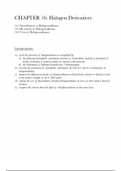

Chemistry As and A level- Halogenoalkanes (Halogen Derivatives)
16.1 Introduction to Halogenoalkanes 16.2 Reactions of Halogenoalkanes 16.3 Uses of Halogenoalkanes Learning outcomes: (a) recall the chemistry of halogenoalkanes as exemplified by (i) the following nucleophilic substitution reactions of bromoethane: hydrolysis, formation of nitriles, formation of primary amines by reaction with ammonia. (ii) the elimination of hydrogen bromide from 2-bromopropane. (b) describe the mechanism of nucleophilic substitution (by both SN1 and SN2 mechanisms...
- Book
- Summary
- • 11 pages •
16.1 Introduction to Halogenoalkanes 16.2 Reactions of Halogenoalkanes 16.3 Uses of Halogenoalkanes Learning outcomes: (a) recall the chemistry of halogenoalkanes as exemplified by (i) the following nucleophilic substitution reactions of bromoethane: hydrolysis, formation of nitriles, formation of primary amines by reaction with ammonia. (ii) the elimination of hydrogen bromide from 2-bromopropane. (b) describe the mechanism of nucleophilic substitution (by both SN1 and SN2 mechanisms...
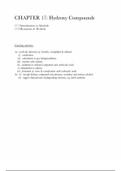

Chemistry As and A level- Alcohols(Hydroxy Compounds)
17.1 Introduction to Alcohols 17.2 Reactions of Alcohols Learning outcomes: (a) recall the chemistry of alcohols, exemplified by ethanol: (i) combustion. (ii) substitution to give halogenoalkanes. (iii) reaction with sodium. (iv) oxidation to carbonyl compounds and carboxylic acids. (v) dehydration to alkenes. (vi) formation of esters by esterification with carboxylic acids. (b) (i) classify hydroxy compounds into primary, secondary and tertiary alcohols. (ii) suggest character...
- Book
- Summary
- • 8 pages •
17.1 Introduction to Alcohols 17.2 Reactions of Alcohols Learning outcomes: (a) recall the chemistry of alcohols, exemplified by ethanol: (i) combustion. (ii) substitution to give halogenoalkanes. (iii) reaction with sodium. (iv) oxidation to carbonyl compounds and carboxylic acids. (v) dehydration to alkenes. (vi) formation of esters by esterification with carboxylic acids. (b) (i) classify hydroxy compounds into primary, secondary and tertiary alcohols. (ii) suggest character...
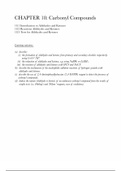

Chemistry As and A level- Carbonyl Compounds
18.1 Introduction to Aldehydes and Ketones 18.2 Reactions Aldehydes and Ketones 18.3 Tests for Aldehydes and Ketones Learning outcomes: (a) describe: (i) the formation of aldehydes and ketones from primary and secondary alcohols respectively using Cr2O7²⁻/H⁺. (ii) the reduction of aldehydes and ketones, e.g. using NaBH4 or LiAlH4. (iii) the reaction of aldehydes and ketones with HCN and NaCN. (b) describe the mechanism of the nucleophilic addition reactions of hydrogen cyanide ...
- Book
- Summary
- • 9 pages •
18.1 Introduction to Aldehydes and Ketones 18.2 Reactions Aldehydes and Ketones 18.3 Tests for Aldehydes and Ketones Learning outcomes: (a) describe: (i) the formation of aldehydes and ketones from primary and secondary alcohols respectively using Cr2O7²⁻/H⁺. (ii) the reduction of aldehydes and ketones, e.g. using NaBH4 or LiAlH4. (iii) the reaction of aldehydes and ketones with HCN and NaCN. (b) describe the mechanism of the nucleophilic addition reactions of hydrogen cyanide ...
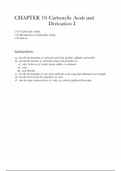

Chemistry As and A level- Carboxylic Acid and its derivatives
19.1 Carboxylic Acids 19.2 Reactions of Carboxylic Acids 19.3 Esters Learning outcomes: (a) describe the formation of carboxylic acids from alcohols, aldehydes and nitriles. (b) describe the reactions of carboxylic acids in the formation of: (i) salts, by the use of reactive metals, alkalis or carbonates. (ii) esters. (iii) acyl chlorides. (c) describe the formation of esters from carboxylic acids, using ethyl ethanoate as an example. (d) describe the acid and base hydrolysis of est...
- Book
- Summary
- • 8 pages •
19.1 Carboxylic Acids 19.2 Reactions of Carboxylic Acids 19.3 Esters Learning outcomes: (a) describe the formation of carboxylic acids from alcohols, aldehydes and nitriles. (b) describe the reactions of carboxylic acids in the formation of: (i) salts, by the use of reactive metals, alkalis or carbonates. (ii) esters. (iii) acyl chlorides. (c) describe the formation of esters from carboxylic acids, using ethyl ethanoate as an example. (d) describe the acid and base hydrolysis of est...
